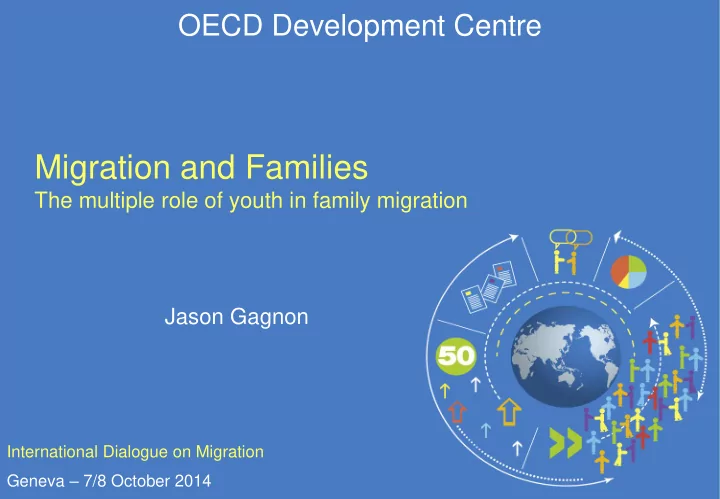

OECD Development Centre Migration and Families The multiple role of youth in family migration Jason Gagnon International Dialogue on Migration Geneva – 7/8 October 2014
What are the current dynamics of youth migration? • Demographic changes • Almost 200 million people are aged between 15 and 24 in Africa, the youngest population in the world, will double by 2045 labour force will be one billion strong by 2040 • 59% of 20-24 year olds will have had secondary education in 2030, compared to 42% today (137 • million 20-24 year olds with secondary education and 12 million with tertiary education in 2030) • Weak labour markets leading to poverty • Between 2000 and 2008, 73 million jobs were created in Africa, but only 16 million for young people aged between 15 and 24 Of Africa’s unemployed, 60% are young people and youth unemployment rates are double those of • adult unemployment in most African countries • On average 72% of the youth population in Africa live with less than USD 2 per day. The incidence of poverty among young people in Nigeria, Ethiopia, Uganda, Zambia and Burundi is over 80%
What drives young people to emigrate? • Younger migrants are different a higher percentage migrate for non-economic reasons, such as education, marriage, family • reunification or refuge • They are more likely to aspire to leave if dissatisfied with local institutions, local economy • school quality, city infrastructure, entrepreneurship opportunities, meritocracy
How are youth incorporated into national security frameworks? • Shortcomings in social security are often a reason for emigration • More youth have irregular migration status, emigrate through irregular channels • Remittances as insurance • Emigrant • youth remit less • daughters more often then men • Staying back • Sharing within household of resources not always equal Cost is higher for youth • • Migrant youth comprise a higher percentage of the ‘unbanked’ and poor • More than three-quarters of the world's poor are "unbanked” • But more likely to innovate in transmission methods (mobile banking) • Integration Youth are more likely to learn local language, adapt quickly •
Are policies adequate? How is youth migration mainstreamed into national development strategies? • Labour market policies beginning to focus more on youth • e.g. Morocco • Good practices • Entrepreneurship, loans, training Vocational training, based on needs in country • Matching, educational reform (Togo) • Basic needs (health, social protection) • • Elements that lack attention non-migration policies • • Migration integrated in development policies • return, circular migration? • diaspora involvement?
A new project Interrelations between public policies, migration and development Case studies and policy recommendations Joint project January 2013 – June 2016 Overall objective Enhance the capacity of partner countries to incorporate migration into the design and implementation of their development strategies .
Partner countries
Added value of the project International Sectoral migration development policies 10 country studies Cross-country analysis
Nine policy sectors Sustainability Environment Health Social cohesion Education Social and skills protection Labour Investment market Economic growth Financial Agriculture Trade services
Youth migration in the project • Questionnaires on emigrants, immigrants and return migrants • Emigrants and return migrants • Why did they leave? • Who helped them? • Do they plan to return? • What are the remittances used for in the household? Immigrants • • Why did they come here? • Who helped them? Do they know anyone here? • Do they plan to return to their home country? • What are the remittances the send back used for? • How well do they feel they are integrated in society here? CROSSED POLICY AND PROGRAMME-ORIENTED QUESTIONS
OECD Development Centre Thank you Jason Gagnon International Dialogue on Migration Geneva – 7/8 October 2014
Recommend
More recommend